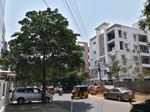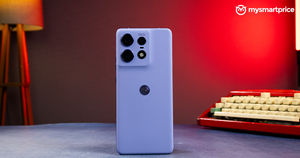
The Samsung Galaxy C9 Pro is a strange beast. Let’s take its Pro moniker, for starters. Samsung usually reserves it for metal clad variants, such as the Galaxy C5 Pro and Galaxy C7 Pro, which are the metal body versions of the plastic C5 and C7 phones without the Pro suffix. The C9 Pro doesn’t have a plasticky counterpart, but that isn’t what’s strange about this phone. What’s stranger is that it’s quite similar to the cheaper Galaxy A9 Pro, albeit with poorer construction and a weaker battery. To its credit, the C9 Pro does offer slightly better (a measly 150MHz of extra clock speed) Snapdragon 653 chipset, extra 2GB of RAM, and a 16 megapixel front camera, but it also demands a premium of around Rs 7,000 over the Galaxy A9 Pro, with an asking price of Rs 36,900.
Samsung Galaxy C9 Pro
What Is Good?
- Great performance
- Whopping 6GB of RAM
- Plenty of storage (64GB)
- 16 megapixel front camera
- Terrific screen
What Is Bad?
- Poor battery life for a 4000mAh phone
- Doesn't ship with Android 7.0 Nougat yet
- Lacks 4K recording
- Lacklustre front camera
- Pales in comparison to the cheaper Galaxy A9 Pro
That also puts it dangerously close (just Rs 6,500 cheaper) to the Samsung Galaxy S7 and quite dearer compared to the OnePlus 3T – both of which are formidable competitors and leaders in their respective categories. Even before we delve into the nitty-gritties, the Samsung Galaxy C9 Pro seems to be in danger of being cannibalised by its own brethren (Galaxy S7 and A9 Pro), while also facing great odds against well-regarded competition that’s priced much lower. Let’s (pretend you didn’t read the review title and…) find out if the Galaxy C9 Pro manages to hold its own
Samsung Galaxy C9 Pro: Design and Build Quality
The inherent ugliness of the C9 Pro’s gold version must be pointed out first and foremost. Regrettably, the phone looks downright hideous with its matte gold aluminium chassis and Gorilla Glass laminated white front fascia. The all black version, however, is quite slick and sophisticated in stark contrast to the gold review unit that I received. Having used the Samsung Galaxy A9 Pro, the difference in build quality is painfully apparent when compared to the Galaxy C9 Pro. For starters, the cheaper A9 Pro has far better build quality.
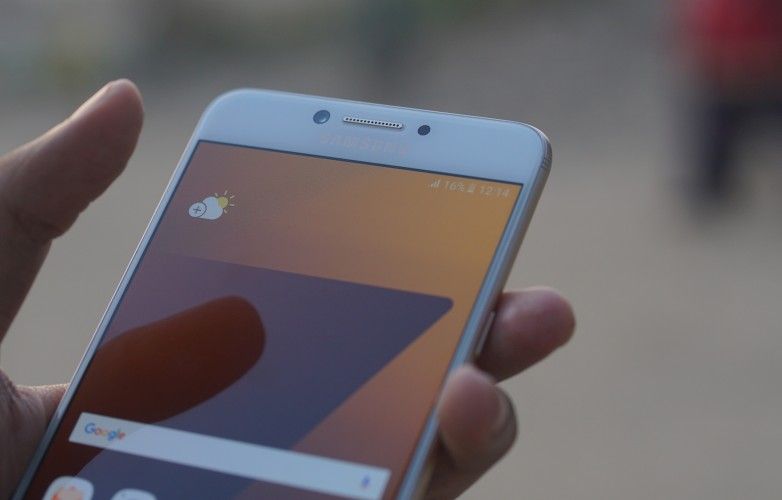
The aluminium employed is vastly superior on the A9 Pro, and the phone feels significantly sturdier compared to the C9 Pro. The A9 Pro survived many severe falls onto hard materials such as granite and marble floors, but it took just one spill from a mere 2 ft onto vinyl flooring to badly shatter the C9 Pro’s screen. While the A9 Pro was protected by Corning’s Gorilla Glass 4 on either faces, it’s not clear which version of Gorilla Glass has been used in the C9 Pro, or for that matter if it even has Gorilla Glass protection. The fact that the phone ships with a screen protector out of the box shows that even Samsung might not be so sure about the phone’s resistance against small drops.
On the bright side, button placement is intuitive, with the volume rocker and power button being within easy reach when the phone is used in the two-handed mode. Speaking of which, the phone’s screen-to-body ratio of a little over 75 percent makes it relatively easier to handle single handed as compared to other 6-inch phones. In fact, it’s only a wee bit larger than the 5.5-inch iPhone 7 Plus, which speaks volumes about the C9 Pro’s design. The phone is relatively thin at 6.9mm and the matte aluminium chassis makes it less likely to slip out of your hand. The 190 gramme heft of the Galaxy C9 pro makes it lighter than the A9 Pro (210 grammes), but that’s heavier than the average phone and you’re going to feel it.
The phone has two separate trays on the right edge – one holding the dual Nano SIMs and another for microSD card. The physical chrome-lined home button doubles up as a fingerprint sensor, which is just as slow and inaccurate as the one on The Galaxy A9 Pro. The physical home button is flanked by two backlit capacitive buttons for Android App Switcher and Back functions. The bottom edge holds the 3.5mm headphone jack, USB Type-C port, microphone, and speaker. Quite interestingly, the earpiece doubles up as the second speaker, making this the only Samsung smartphone to offer stereo loudspeaker setup. Unfortunately, the nature and the orientation of the earpiece with relation to the second loudspeaker on the bottom edge leads to a disorienting stereo image and a flagrantly tinny audio signature. You’re better off disabling the feature from the settings menu.
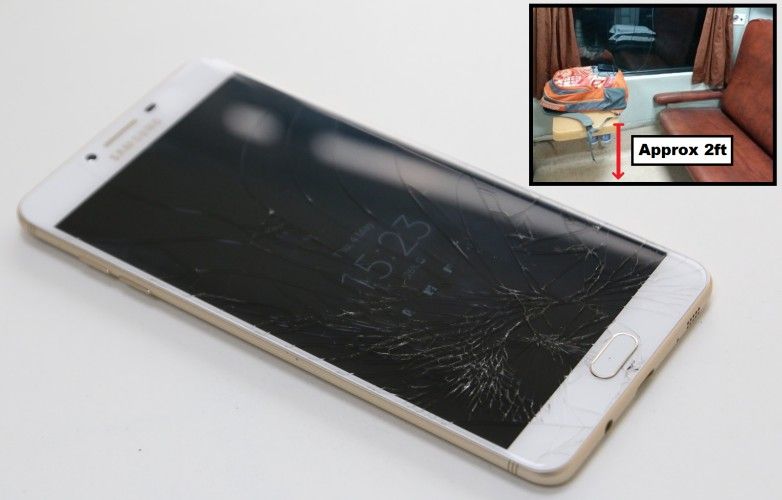
Samsung Galaxy C9 Pro: Hardware, Connectivity, and Performance
The Samsung Galaxy C9 Pro is outfitted with the Snapdragon 653 chipset and an excessive 6GB of RAM. The chipset is only marginally faster than the Snapdragon 652 found in the cheaper Galaxy A9 Pro. In raw numbers, the four performance A-72 cores of the C9 Pro are merely 150MHz faster than the ones in the A9 Pro, whereas the four efficiency cores have similar performance figures. In effect, that leads to a 150 odd points of improvement over the A9 Pro in the Geekbench multi-core tests with a score of 3994. The Antutu score, however, looks favourable at 83,762 compared to the A9 Pro’s score of 74,218.
The net performance benefit over the Galaxy A9 Pro is not very conspicuous either. I may not have had the opportunity to do an A/B comparison vis-a-vis the Snapdragon 652 equipped A9 Pro, but the C9 Pro doesn’t feel all that different. The UI and pretty much all apps run lag and stutter free on both the phones, whereas the ever-so-clunky Facebook app tends to struggle on both phones on an equal basis. Apps open and switch quickly and both the phones have enough memory to keep plenty of apps in the background. In fact, switching back to the apps that have been kicked off memory is fast enough to make no appreciable difference.
This makes one wonder what’s the point of shoving in 6GB of RAM in a mid-range chipset, where even 4GB of RAM clearly doesn’t bottleneck the processor. You have plenty of flagship phones running Snapdragon 820 and 821 chipsets with 4GB of RAM without a hitch. I believe Samsung would have been better off reallocating its extra RAM budget towards a better chipset – an alternative that would’ve delivered visible performance gains. Then again, you have people in the smartphone industry themselves admitting that shoving 6GB of RAM into phones is a lazy alternative to optimisation. And the fact that the Google Pixel delivers the smoothest Android experience with 4GB of RAM speaks volumes about this school of thought.
It’s clear that Samsung has used the 6GB RAM option to attain parity with the OnePlus 3T, but that’s moot considering the phone packs in a better chipset for cheaper and leaves the Galaxy C9 pro in the dust when it comes to performance. Nevertheless, be it Asphalt Airborne 8 or Modern Combat 5, the Galaxy C9 pro handles all games with aplomb. The phone is pretty well-equipped in the connectivity department with support for dual-band Wi-Fi 802.11ac standard, Bluetooth 4.2, and great network reception as well as 4G internet access. The GPS works like a charm too; locking on quickly and delivering precise turn-by-turn navigation without losing the GPS signal at any point. The 64GB of storage, which is sadly the slower eMMC type, combined with a microSD card slot also means that you won’t be wanting for space on this phone.
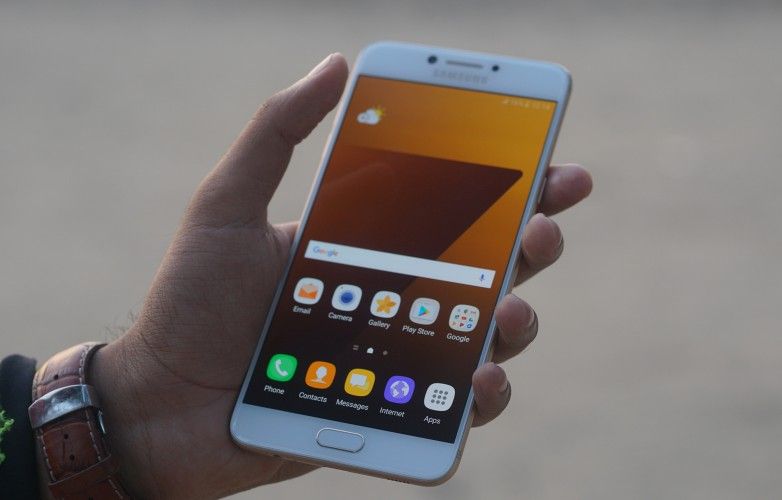
Samsung Galaxy C9 Pro: Display, Software, and UI
Samsung is peerless when it comes to smartphone displays thanks to the countless amount of money it has sunk into R&D for AMOLED displays. Although, you don’t get an obscenely good HDR capable panel found in the Samsung galaxy S8, the 6-inch Super AMOLED display here is pretty damn stellar by all measures. A resolution of 1080×1920 pixels might seem low-rent for a 6-inch display by today’s standards, but we’re still looking at a pixel density of 367ppi, which results in sharp and crisp images. However, AMOLED screens go beyond just being sharp. The colour gamut is wide and exhibits the tell-tale high-saturation characteristic of Samsung’s AMOLED phones. And because emissive displays can switch individual pixels off, the black levels are unprecedented, which in turn makes the claimed 100,000:1 contrast ratio seem somewhat plausible. The viewing angles are wide and don’t exhibit much colour shift either. It’s not surprising that the display excelled in all my objective tests.
The C9 pro ships with Android 6.0.1 Marshmallow out of the box; however, the phone is expected to get a Nougat update, although it hasn’t been officially confirmed yet. That’s disappointing for a phone as new as this, but then again, Samsung needs some time to make sure its heavily modified fork plays well with the latest version of Android. The C9 Pro runs the TouchWiz UI baked on top of Marshmallow. It’s exactly the same sort of affair you’ll find on any of the recent Samsung Galaxy phones, so you might want to check out this review for a more detailed explanation of TouchWiz exclusive features.
Samsung Galaxy C9 Pro: Camera
The Galaxy C9 Pro is outfitted with a 16-megapixel rear and yet another 16-megapixel front camera, both of which sport an aperture of F1.9. The rear camera is equipped with phase detection autofocus and dual tone/dual-LED flash, which makes it pretty fast at acquiring images, as long as you’re shooting in daylight and avoiding macro photography. For starters, the rear camera is a definite improvement over a similarly specced unit found in the Galaxy A9 Pro. The unit focuses and acquires images quickly. The photos come out sharper, contain greater degree of details, and more accurate colours as well. Gone is the softness that was apparent in the photographs shot by the A9 Pro’s rear camera. It’s a great camera, as long as you have enough light, but don’t expect it to compete with the OnePlus 3T.
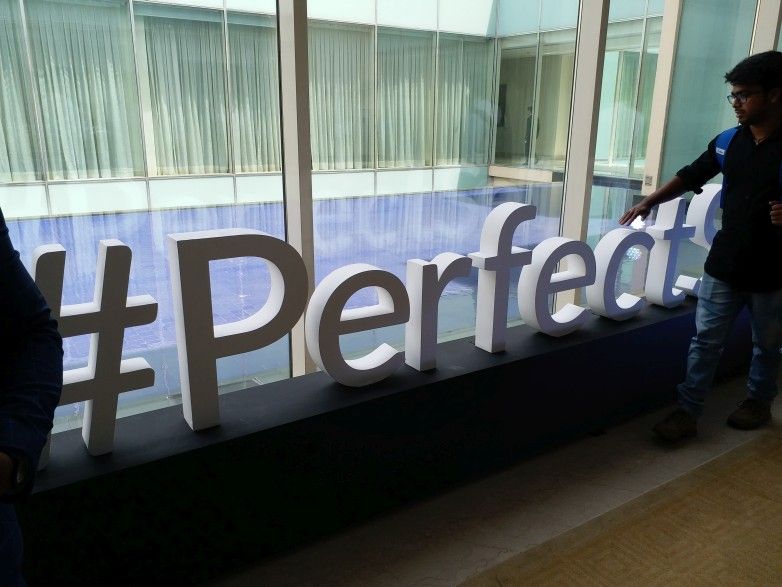
The C9 Pro, however, lacks optical image stabilisation (OIS), so don’t expect it to take sharp images under low-light conditions, where even quick focusing and image acquisition becomes an issue. I also found that the camera took longer to focus when shooting close-up/macro shots, with the snapper proving unable to focus on objects even when it’s reasonably far away from the subject by the standards of a macro shot. The front camera is similarly disappointing. At 16 megapixel, it has twice as many pixels as the front camera of the Galaxy A9 Pro, but it nevertheless has as many issues plaguing it. Selfies end up looking soft. That might mean loss of details, but at least the photographs don’t look posterised and artificial as the ones snapped by the A9 Pro’s front camera. The colours and white balance are way off the mark as well, which affects skin tones. So don’t expect the phone to capture your natural beauty, or the inherent lack of it. Low light performance isn’t great either, as there’s some considerable loss in detail. The camera also has a hard time focusing in these conditions.
Thankfully, the camera gets the basics right with decent quality, optically stabilised 1080p video recording, geo-tagging, touch focus, face detection, panorama, and HDR modes. Just don’t expect 4K and 60fps recording, which some phones such as the OnePlus 3T offer for cheaper. The camera interface is a standard affair with one of the screen edges meant for the virtual camera shutter button, video recording button, camera switching, and preview, whereas the other edge has options handy for settings, picture resolution/aspect ratio, flash, timer, and effects such vintage, cartoon, and greyscale. Additional modes include the standard Panorama, which is decent enough to capture wider vistas and a Pro mode that gives control over exposure, ISO, metering, and white balance. The continuous shot snaps a series of images in rapid succession. Furthermore, you can download additional effects and modes such as the animated GIF, Sports Shot, and Beauty Face.

Samsung Galaxy C9 Pro: Battery
The Galaxy C9 Pro’s 4000mAh battery is substantially smaller than that the 5000mAh one found on the A9 Pro. It’s not surprising that the C9 Pro doesn’t deliver the phenomenal battery backup of the A9 Pro, but what’s surprising is just how worse off the C9 Pro fares in comparison. I had managed to eke out 12 hours of screen-on time with the Galaxy A9 pro, but the C9 Pro could only muster up little more than 6 hours. While that’s good enough to sail you through a day, one wonders why Samsung couldn’t optimise the power consumption on the C9 Pro as well as it did on the A9 Pro.
While I agree that the extra 2GB of RAM and 150MHz clock speed boost will lead to some extent of increased power consumption, it still shouldn’t halve the battery backup. Especially, considering the fact that we aren’t dealing with a Quad HD display, but the same Full HD panel found in the A9 Pro. Here’s hoping Samsung fixes this issue through a firmware update in the future. Thankfully, the fast charging feature combined with compatibility with any Quick Charge 2.0 charger allows the phone to go from 0 percent to full charge in a little under two hours. The provided USB Type-C to microUSB adapter also means that you can continue to charge this phone with your existing microUSB charger.
You can further extend the battery backup by an hour or so with Samsung’s own power saving schemes. This includes the S Power Planning feature that allows you to either reserve battery for calls, which disables everything except the most essential calling and messaging services, or chose from other power management alternatives. The alternatives include Extend Battery Time that enables the Ultra Power Saving Mode, which in turn disables unnecessary functions and processes and switches off the radios for Wi-Fi and mobile data when the screen is switched off. The last option allows you to forward calls to another phone number when the battery is just about to die, thereby allowing you to route the calls to a backup phone or to a close confidante, who can be notified with an SMS that your calls are being re-routed.
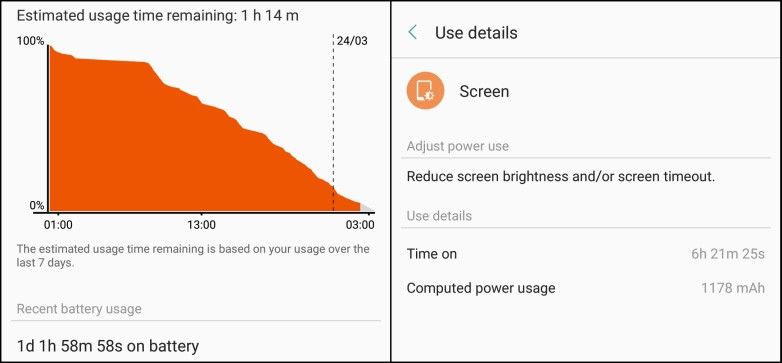
Samsung Galaxy C9 Pro: Verdict
It’s no secret that Samsung is an electronics behemoth. While that gives it great brand appeal across a wider demographic, that also means it has to deal with greater overheads for R&D, marketing, and maintaining brick-and-mortar retail outlets and the traditional offline sales route. It is for this reason, it’s hard for the Korean electronics giant to match its Chinese competitors when it comes to features and value for money. Apart from phone geeks, a vast majority of regular junta that doesn’t care about SoCs and megapixels nevertheless prefers Samsung for its brand value.
It is, for this reason, moot to compare the Samsung Galaxy C9 Pro with the cheaper and objectively better OnePlus 3T, and therefore we are going to get past that foregone conclusion (that is, stop reading and go for the OnePlus 3T instead) and instead focus on the sort of consumer who wants a Samsung smartphone and nothing else. Well, if you’re that guy, you are better off spending a little under Rs 30,000 for the Galaxy A9 Pro, which is quite a bit cheaper than the Rs 36,900 asking price of the Galaxy C9 Pro. While the performance and camera are marginally better, you’d be hard pressed to tell the difference in day-to-day usage. But on the flip side, the A9 Pro objectively looks better and is built sturdier as well. Its 5000mAh battery, with a screen-on time of 12 hours also trumps the C9 Pro’s battery endurance figures, making the A9 pro a far more practical choice.
On the flip side, you can even spend Rs 6,500 extra and opt for the Samsung Galaxy S7 instead. The last year’s flagship is infinitely better than the Galaxy C9 Pro in every conceivable aspect. This deal will be even sweeter when the Galaxy S8 hits the streets; thereby inevitably prompting a price drop for the Galaxy S7. At any rate, the Samsung Galaxy C9 Pro is a decent enough phone, but it makes little sense when you have the vastly better looking and longer lasting Galaxy A9 Pro available for as much as Rs 7,000 less. Even if you’re enamoured by the idea of a phone with 6GB RAM and must buy the C9 Pro, I’d recommend waiting for a price drop.




